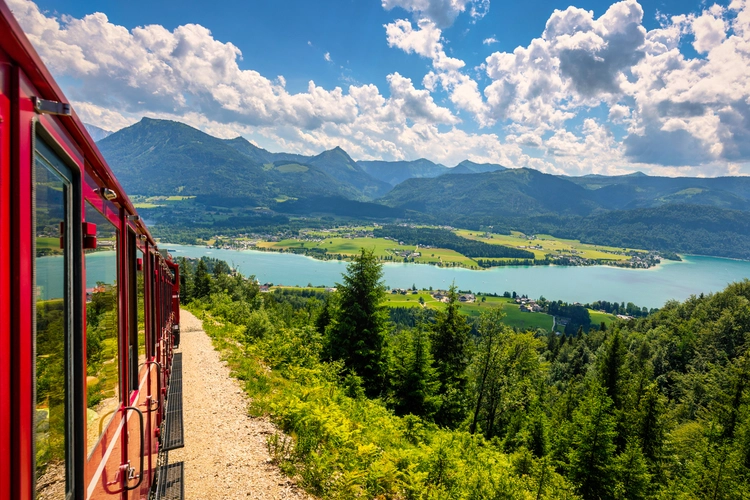Is there any mode of transport so pleasant… so relaxing… so civilized… as train travel?
In Europe, at least, I’d say no.
Throughout Western Europe (Portugal, Spain, France, the U.K., Germany, Italy, Switzerland, Austria), and much of Central Europe (Poland, the Czech Republic, Slovakia, Slovenia, Hungary, Croatia, Bosnia-Herzegovina, Montenegro, Serbia, North Macedonia, Albania), train networks are abundant and efficient.
Within Two Train Hours Of Our Favorite Euro Havens
| From | To |
|---|---|
| Croatia | Slovenia - Austria - Italy |
| France | Belgium - Germany - Italy - Austria - Switzerland - Spain - U.K. - Luxembourg - Monaco |
| Germany | Austria - Belgium - Luxembourg - France Netherlands - Switzerland |
| Hungary | Slovenia - Austria - Italy |
| Italy | France - Switzerland - Croatia - Slovenia Monaco |
| Montenegro | Slovenia - Austria - Italy |
| Portugal | Spain |
| Spain | Portugal - France |
Within all of my favorite countries, trains often make more sense than flying or driving. From Paris, I can be across the country in under two hours and on the southern coast in about four.
It’s a couple hours to the Normandy coast and just 20 minutes more to the U.K…. an hour 15 to Brussels, 3 to Amsterdam or Geneva… and those are just the closest direct rails.
Within an hour of the city, which is a different, less expensive (but slower) rail system than the national network, there are dozens of lakes, forested parks, nature reserves, chateaux, medieval towns, the national sheep farm as well as many other farms for cattle, pigs, poultry, and all else, picking farms, Roman sites, artistic hubs, and, lest we forget, Disneyland.
And while I’m speaking specifically about Paris above, nearly the same list would apply to any major European city and what it’s got in its immediate environs. (Disneyland is the big exception!)
Trains don’t always make the most sense, of course. Mountains, of which Europe has plenty, tend to pose obstacles. To get through the Alps, in particular, is a long and tedious route…
From France into Italy and Switzerland or farther east, trains don’t make much sense.
Luckily, on the other side of the continent, the Pyrenees pose less of a problem. From Valencia, Barcelona, or Madrid into France is quick and easy.
And, in France at least—and much to the earth’s benefit—we have little choice other than train in many cases.
In May 2023, the country passed a ban on short-haul flights with a train alternative of less than four hours.
Italy is likewise on a campaign to encourage train travel, with exciting new rails planned both domestically and going to Germany in 2026. The new German lines will offer direct routes from Berlin and Munich into Florence, Rome, and Venice.
In 2024, three new domestic lines will be opened for tourists, including express trains featuring 1980s and ’90s-era cars upgraded with dining and sleeping cars and storage areas.
The historic train lines that will be launched will feature 400 historic and protected vehicles and offer tourist activities like guided tours, walking routes, and tastings.
The most anticipated part of the plan is a reprisal of the Orient Express line after its 46-year hiatus. New routes are offered, veering off the original route and taking passengers up and down Italy’s length, and internationally heading to Paris, Croatia, and Istanbul.
Plus, all existing and new routes are being optimized to take tourists to lesser-visited historical sites and towns, to help relieve pressure on over-touristed sites.
As a sustainable form travel, many countries in Europe are similarly looking to expand or upgrade their rail networks, both small- and large-scale. Berlin, for example, is introducing new cars on the metro lines this year, and there have been proposals to add new lines to the U-Bahn beginning in 2030.
Those famous Eurail passes that every American has traveled to Europe on since the ’60s are as good a deal as ever—about US$250 for access to 33 counties—but is only available to those not resident in Europe…
But once you settle down over here, there are still plenty of good deals to be had on train travel.
The European version of Eurail, Interrail, starts at 317 euros (232 for seniors) and offers 40,000 destinations in 33 countries.
You can also opt for a single country pass for one of 30 countries participating. These passes are customizable and can be valid for anywhere from 3 days to 3 months.
Within each country, too, there are likely to be discounted annual passes for frequent travelers on the national lines. France’s SNCF offers a “liberty card” for 400 euros a year that lets you travel anywhere anytime in France.
Failing that, some national networks, like Spain’s, offer loyalty programs that come with reward points and discounts on lounges, parking, hotels, etc.
Today’s missive may seem like a digression from our usual beat—more about travel than about living overseas. Trust me, it’s not.
Train travel (and public transport in general) in your new life overseas is a game changer. It’s the harbinger of a completely changed lifestyle.
Thanks to trains, trams, and metros, you’ll do a lot more walking and a lot less driving in your new life overseas. Your health will improve without you making any conscious effort, and I’d bet your mental wellbeing will benefit, too. Imagine—no more road rage, lost time in traffic, and missing the scenery as you focus on the road.
You’ll also save bundles on the cost of transport—my husband and I estimated that our costs were down about 25% from Panama to Paris thanks to ditching our car.
Transportation is the second biggest expense for Americans over 65, according to the Bureau of Labor Statistics (after housing and before health care), and it’s so easy to drop that cost to a mere few hundred bucks a year.
Not to mention the environmental benefits.
Plus, lest we forget, cars are dangerous. When you factor in deaths due to vehicle accidents, rural and suburban areas have death rates on par with cities with high homicide rates.
North Americans tend to dismiss public transport out of hand, thinking it’s too inefficient or that there’s some kind of class distinction to not taking the bus. That might be true in some parts of North America, but in much of the world, it’s either unnecessary or downright inefficient to drive a car.
In European cities, for example, the majority of the population uses public transport, which is quick and affordable, and possibly the easiest way to get connected to your new adopted home.
By using the buses and trains along with locals, you’ll see a side of your new home that you wouldn’t if you stuck to cars and taxis… You’ll hear more of the language, see more of the culture, and feel like you’ve earned your insider knowledge through your own experiences.
When you couple that with all the scenery you’ll soak up through the windows as you’re shuttled across countries… and simply taking the train starts to look like one of the most underrated ways to discover your new home.
Hurrah, I say!
Let’s get on board… pun intended… and leave planes in the dust.
Happy trails,
Kat Kalashian
Editor, LIOS Confidential








